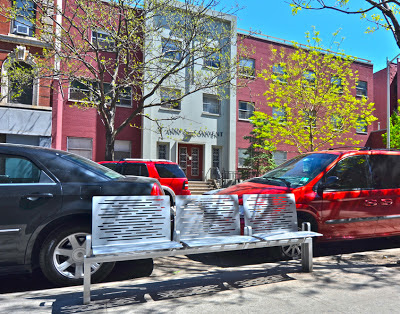Roberta Hodgson
 |
The elevated subway grates on East 116th Street are designed to prevent flooding and also serve as public art and a bench. |
“I came down the front steps of my house into a world that was sunny, warm and clean….
with benches, where mothers sat with their carriaged babies,” novelist E.L. Doctorow wrote recently in New York magazine, describing his Depression-era childhood in New York City.
Seventy five years later, benches still provide comfort and convenience in what serves as our common outdoor living room: the sidewalks of New York. The problem is that there are not enough benches to accommodate seniors, shoppers, and families looking for a spot to sit. Seniors often find it difficult to walk several blocks without a place to rest. And New Yorkers of any age appreciate a bench to sit on, chat with a friend or share an ice cream with a child. Interrupting the relentless pace of the city by stopping to sit and smell chestnuts roasting or to notice pear trees in bloom can only be good for everyone’s peace of mind.
Now a solution to the problem of too few benches is at hand–a new program from the NYC Department of Transportation (DOT) known as CityBench. In order to increase the amount of public seating on our streets, DOT is now installing attractive and durable benches around the city, particularly at bus stops, retail corridors, and in areas with a high concentration of senior citizens. As DOT Commissioner Janette Sadik-Khan explained in a recent interview, “New York has it all but it also needs places to take it all in.”
For Sandra Talavera, a social worker, resident of East Harlem and wife of CIVITAS President Felipe Ventegeat, this is not a new story. Over the past few years she worked with the city’s Department for the Aging, and has found that a major concern is the lack of seating in public areas. “The seniors,” she said, “actually just wanted a place they could sit down and rest close to their supermarkets and bus stops." Working with the New York Academy of Medicine at 103rd Street, Community Board 11 and Council Member Melissa Mark-Viverito, Sandra helped draw up a strategic plan to place more than 300 benches for seniors throughout the city.
 |
A DOT CityBench installed outside the Leonard Covello Senior Center. |
Stressing the importance of these plans, Ruth Finkelstein, senior vice president for policy and planning at the Academy explained, “For older adults, benches are exercise to get to, and they are social engagement and anti-depressants.” East Harlem was one of the first areas with a CityBench. Located outside the Leonard Covello Senior Center on 109th Street between First and Second Avenues, it is a comfortable open-sided, slatted bench with sturdy end bars in a sleek silver metal.Convinced that durable benches make streets more welcoming for everyone, encourage walking, and are a civic amenity, DOT has made CityBench available to the entire city.
“One of the complaints about public seating was that it was too narrow,” says Ignacio Ciocchini, a bench designer with Chelsea Improvement Company. His designs for DOT have wide seats allowing for more personal space and room for a bag or pet. DOT welcomes experimentation with location and design. For example, a simple backless model bench relates well to other street furniture and costs about $1,800 to fabricate. Benches with armrests are useful both to help people to get out of the seat and to divide a bench so that more people can fit on it. Many benches are made of domestic carbon steel similar to that used on cars. This anti-rust design requires very little maintenance.
Anyone can request a bench by contacting citybench@dot.nyc.gov and filling out a form or by phoning (212) 839-6569. Priority bench locations include bus stops without shelters, senior centers, libraries, hospitals, and high-density shopping areas. Located online are detailed requirements about where benches may go for safety and engineering reasons. This program is funded by a $2.4 million grant from the federal government with the last 10 percent funded by the city.
Private initiative can also give birth to a bench. Food Passion, Peter Walter’s store on Lexington Avenue, has a welcoming white slated bench on the sidewalk near the front door. Asked who paid for it, he replied, “we did because we enjoy seeing our customers, and for that matter anyone, enjoying the bench as they do everyday.” Asked about vandalism, he replied, “Not a problem.” DOT also states vandalism is rare and that the key to prevention is locating benches where adjacent shop owners and neighbors will assume some responsibility for their use and maintenance.
Community Board 8’s office says that any store owner can put a bench on the sidewalk in front of their store as long as it is flush to the building, does not interfere with pedestrian traffic, and is removable. Eli’s Manhattan and other stores on Third Avenue have seen the benefit of sidewalk benches, and recently placed them in front of their shops.
In the big picture, benches—both publicly and privately financed—fulfill some of the Mayor Bloomberg’s PlaNYC 2030 goals to prepare the city for additional walkers on the streets and a more carbon-free environment.
To learn more, visit the Department of Transportation website: www.nyc.gov/html/dot/html/pedestrians/citybench.shtml
To read the complete spring 2013 issue of CIVITAS News, visit http://civitasnyc.org/civitas-newsletters/
No comments:
Post a Comment